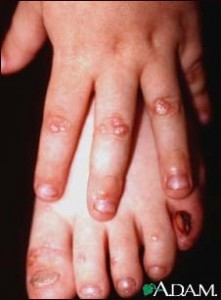Alternate Names : Junctional epidermolysis bullosa, Dystrophic epidermolysis bullosa, Hemidesmosomal epidermolysis bullosa, Weber-Cockayne syndrome
Definition
Epidermolysis bullosa is a group of inherited disorders in which skin blisters develop in response to minor injury.
Overview, Causes, & Risk Factors
There are four main types of epidermolysis bullosa:
- Dystrophic epidermolysis bullosa
- Epidermolysis bullosa simplex
- Hemidesmosomal epidermolysis bullosa
- Junctional epidermolysis bullosa
Another rare type of epidermolysis bullosa, called epidermolysis bullosa acquisita, is an autoimmune disorder. It may be difficult to tell this condition apart from another autoimmune skin disorder called mucous membrane pemphigoid.
Depending on the type of epidermolysis bullosa, the condition can vary from minor blistering of the skin to a lethal form involving other organs. The condition generally starts at birth or soon after. Epidermolysis bullosa acquisita, however, usually appears in adults over age 50, although it can occur in children. Also, mild cases of epidermolysis bullosa simplex may remain undiagnosed until adulthood.
Identifying the exact type of epidermolysis bullosa is complicated. Even within the main types listed above, there are many subtypes. For example, Weber-Cockayne is the most common form of epidermolysis bullosa simplex. This type involves blistering of the palms and soles and may include excessive sweating.
All of the different types of epidermolysis bullosa are generally inherited. Therefore, having a family history of the disease, and especially having a parent with it, is a risk factor. The inheritance pattern may be dominant or recessive. A dominant form means that a child can inherit the disease if only one parent has it. The recessive form means that both parents must carry a gene and transmit that gene to the child in order for child to have the disease. The recessive forms of epidermolysis bullosa tend to be worse.
The hallmark of these conditions is the formation of large, fluid-filled blisters that develop in response to minor trauma. Some infants may have large blisters at birth. Others start shortly after birth. Chafing (wearing away) of the skin, rubbing, or even increased room temperature may cause blisters to form.
In the severe forms, scarring after blister formation may cause deformities, fusion of the fingers and toes, and contracture deformities (for example, at the fingers, elbows and knees). If the mouth and esophagus are involved, blistering and scarring lead to feeding and swallowing difficulties.
Secondary infection is common.
Pictures & Images
Epidermolysis bullosa, dominant dystrophic

This picture shows skin lesions (epidermolysis bullosa) over the joints on the hands and feet (interphalangeal joints). Dystrophic epidermolysis bullosa is an inherited condition that causes red blisters (bullae) that break open, ooze, form scabs (crusts), and scar.
Epidermolysis bullosa, dystrophic

This picture shows skin lesions (epidermolysis bullosa) over the joints on the hands and feet (interphalangeal joints). Dystrophic epidermolysis bullosa is an inherited condition that causes red, blisters (bullae) that break open, ooze, form scabs (crusts), and scar.
-
Epidermolysis bullosa : Overview, Causes, & Risk Factors
-
Epidermolysis bullosa : Symptoms & Signs, Diagnosis & Tests
-
Epidermolysis bullosa : Treatment



Review Date : 10/31/2008
Reviewed By : Kevin Berman, MD, PhD, Atlanta Center for Dermatologic Disease, Atlanta, GA. Review provided by VeriMed Healthcare Network. Also reviewed by David Zieve, MD, MHA, Medical Director, A.D.A.M., Inc.
The information provided herein should not be used during any medical emergency or for the diagnosis or treatment of any medical condition. A licensed medical professional should be consulted for diagnosis and treatment of any and all medical conditions. Call 911 for all medical emergencies. Links to other sites are provided for information only — they do not constitute endorsements of those other sites. © 1997- 2010 A.D.A.M., Inc. Any duplication or distribution of the information contained herein is strictly prohibited.
